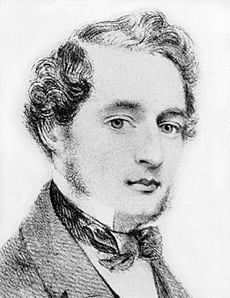Rancho Laguna de la Merced facts for kids
Rancho Laguna de la Merced was a large piece of land in California. It was also called the Galindo ranch. This land was about 2,219 acres (9 square kilometers). It was located in what is now southwestern San Francisco and northwestern San Mateo County, California. In 1835, Governor José Castro gave this land as a grant to José Antonio Galindo. The ranch included the area around Lake Merced in San Francisco. It also covered parts of modern-day Daly City, like the neighborhoods of Westlake and Serramonte.
Contents
History of the Rancho
José Antonio Galindo was a soldier in the Presidio of San Francisco militia. This was in a region called Alta California, which was part of Mexico. His family had been in California since 1776. In 1835, José Antonio Galindo received the Rancho Laguna de la Merced land grant. He also received another grant called Rancho Saucelito. His mother, Ramona Sanchez de Galindo, also received a land grant in 1838 called Rancho Butano.
Changes in Ownership
José Antonio Galindo did not develop Rancho Laguna de la Merced much. He sold it in 1837 to Francisco de Haro. De Haro was an important leader, known as the Alcalde, or mayor, of San Francisco. Francisco de Haro died in 1849.
After the Mexican–American War, California became part of the United States. The 1848 Treaty of Guadalupe Hidalgo said that the US would respect existing land grants. So, in 1852, a claim for Rancho Laguna de la Merced was filed. This was done with the Public Land Commission. The land grant was officially approved, or patented, in 1872. It was given to De Haro's children: Josefa de Haro Guerrero Denniston, Rosalia de Haro Andrews Brown, Natividad de Haro Castro Tissot, and Carlotta de Haro Denniston.
Land Disputes and Settlers
The De Haro family tried to claim land between Lake Merced and San Bruno Mountain. However, a US government survey in 1853 said this area was government property. This meant private citizens could claim it. Many people, called squatters, moved onto the land. They hoped that a new law, the Homestead Act, would give them legal ownership of 160 acres if they lived there.
The Greene brothers arrived in California around 1847. They settled on part of Rancho Laguna de la Merced. Later, David Mahoney bought Rancho Laguna de La Merced. He wanted to expand his property north to more valuable land. His new survey included the Greene brothers' homestead. This led to a big legal battle.
The Greene brothers won their case in a lower court. But Mahoney appealed to the US Supreme Court. The Greenes lost their case there. They refused to leave and built a strong fort to keep out authorities. The Greenes stayed in their fort for three months. Finally, a special law was passed by Congress in 1887. This law gave the Greenes legal ownership of their land.
Another person, Robert S. Thornton, also claimed land south of Lake Merced. He represented about thirty property owners in the Colma area. Their land titles were also at risk. In 1865, they won their case in the US Supreme Court.
Water Rights and Sales
The Spring Valley Water Company bought the water rights for Lake Merced in 1868. By 1877, they started buying the land around the lake that collected water for it. The company began selling off its land around Lake Merced starting in the 1890s.


